Picto Diary - 14 October 2015 - WWI Western Front - Epilogue One
2015 was my year to understand WWI.
Though I have a general interest in history, I didn't have any plan for a 2015 immersion in WWI history. But two "friends" turned me towards WWI. "Serendipity," and Malcolm Moore.
Malcolm and his family had recently published the memoirs of his grandfather, ANZAC "Jack" Moore, a Kiwi who served with the Royal Australian Corps of Engineers during WWI. ANZAC Jack took part in the first landing of ANZACs at Gallipoli, on 25 April 1915. Malcolm's 90 year old dad was invited by the Australian Army Engineers to join on a 100 year anniversary tour of Gallipoli. Malcolm took his dad's place and facilitated my participation in the tour as a member of ANZAC's family... a true honor.
I had been to Gallipoli two times previously... once in September 2014, sailing through the Dardanelles on Seabourn cruise ship in 2014, and another time, while motorcycling, clockwise, up the Anatolian coast from Antalya, circa 2003. On neither of the first two Gallipoli visits did I study the WWI story in depth. I knew, though, having lived in Australia in the mid 70's, that the ANZAC invasion was central to Australia's national identity. Somewhere in that period I watched the Peter Wier movie, "Gallipoli," with Mel Gibson.
Touring Gallipoli in April 2015 with the modern day ANZACs and Malcolm, I augmented my knowledge of the Gallipoli invasion considerably... by walking the ground, by listening to the superb story telling of battlefield Rod Margetts, and by reading considerably, including "Gallipoli," by Alan Moorehead, published circa 1956.
After my Gallipoli trip, I felt compelled to put my Gallipoli knowledge in the broader context of WWI. Looking back, I remember studying WWI in school but my understanding through 2014 was vague. WWII (2) lore... books, movies, TV... seems to inform most of what I know about Americans fighting in Europe. This year, 2015, to augment my knowledge of WWI, I read Tuchman's "The Guns of August," and Hasting's "Catastrophe" for starters. I read from various other sources trying to piece the complex elements of WWI into a coherent whole in my mind.
I was, therefore, very pleased when, this summer, 1% and Comic Mom (Dardanelles September 2014 cruise companions) showed an interest in visiting the WWI battlefields of northern France and Belgian Flanders... areas of battle looked at from the British point of view...the Western Front... trench warfare. We, including my son and his wife, and 1%'s and Comic Mom's sister in law, and Comic Mom's cousin, signed up for a Western Front battlefield tour which take place in late September 2015.
My picto diaries of the last 10 or so days of September 1915 chronicle my observations and growing understanding of WWI after visiting some of the battlefields of the Western Front... under the leadership of another great battlefield guide, Patrick Mercer.
Then... came another serendipitous insight.
WWI was truly a global war. Without initially realizing it, my travels over the last ten years, a lot of it accomplished by motorcycle, had taken me to many other parts of the world that were engaged in the WWI conflict. The Western Front, and Gallipoli, to some extent, "take the air out of the room," when the subject is WWI. But, there were other areas of WWI importance. I reviewed my Picto Diary to pinpoint some of the areas I had visited in recent years having a WWI connection. My WWI battle field tour has turned out to be more extensive than I thought!
Here's a summary that "augments" my 2015 WWI tours of the Western Front and Gallipoli:
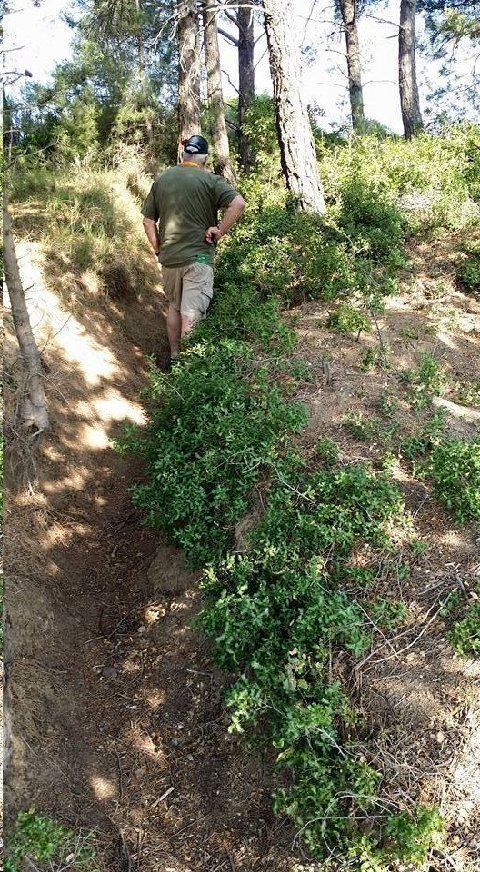
Above: The Bishop standing at forward ANZAC trenches (eroded significantly over 100 years). Quinn's Post. 1 km inland from landing beach atop 2nd Ridge. Gallipoli Battlefield. Turkey. 30 April 2015. Turkish trenches only 10 meters away at this point.
My picto diary has extensive coverage of my trip to Galippoli in April/May of this year (2015).
In the context of my September 2015 visits to the Western Front I now better understand Gallipoli's role in WWI.
Gallipoli is unique among WWI campaigns. The fighting at Gallipoli brought together modern amphibious assault and multinational combined operations. Gallipoli became, perhaps, the greatest 'what if' of the war. If the strategy had been successful, it might have led to the ending of the war two years early on Allied terms. This might have avoided the bloodletting of 1916-18, saved Tsarist Russia from revolution and side-stepped the disastrous Treaty of Versailles - in effect, altering the course of the entire 20th century.
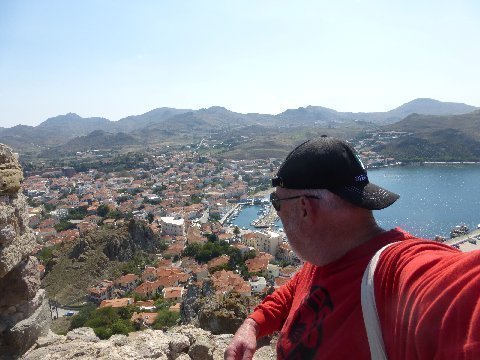
Above: The Bishop looks over Myrina harbor, Greek Island of Lemnos, from top lookout at Myrina Castle. 14 September 2014. After this image was captured, Comic Mom and (Mwah) enjoyed a sea food lunch at Myrina beach.
During WWI, the Allies in early 1915 used Lemnos to try to capture the Dardanelles Straits, some 31 miles away. The harbor of Mudros bay, which I saw as our Seabourn cruise ship rounded Lemnos, was the center for the Allied buildup for the attack on Gallipoli.
Churchill was the main advocate for using Lemnos as a staging area. Though Moudros harbor was broad enough for British and French warships, the island was inadequate for large scale military staging operations. Insufficient water supply was one reason. Troops intended for Gallipoli, therefore, had to train in Egypt. Moudros' importance receded, although it remained the Allied base for the blockade of the Dardanelles during the war.
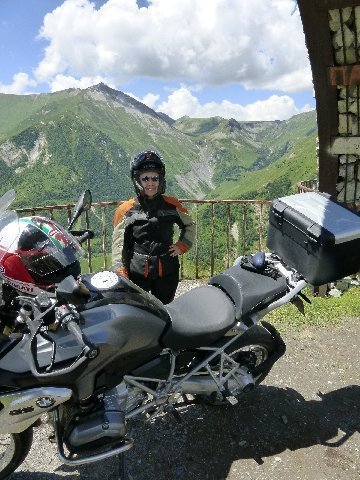
Above: TIMDT at rest overlook on Georgia Military Highway. Georgia. 03 July 2014.
In July of 2014, TIMDT and Mwah (sic) motorcycled through northeastern Turkey, Georgia, Armenia, Azerbaijan, Dagestan, Chechnya, Ingushita, and North Ossetia... both sides of the Caucasus Range.
At the time, I correlated my Caucasus travels to the rise of Josef Stalin, a Georgian, whose life was shaped by his experiences as a radical, anti Tsarist, operative in Batumi, Gori, Tiblisi, and Baku... all places visited by TIMDT and Mwah (sic). Stalin's father was born in South Ossetia. I had read Simon Sebag-Montifiore's "Young Stalin," for the second time before undertaking the Caucasus motorcycle trip.
As the Caucasus region relates to WWI, however, I had some awareness of the Armenian "Genocide" knowing that it arose out of Ottoman distrust of Armenian loyalty to the Central Powers once the Ottoman Empire declared itself a Central Powers belligerent. The Armenian genocide occurred between 1915 and 1918 with, by some estimates, 1.5 million people killed.
Filling in some more of the "Caucasus" WWI blanks....
The objective of the Ottoman Empire in the Caucasus Campaign was to recover territory lost to the Russians in the Russo-Ottoman war in 1877-78. The problem was that the Caucasus had many different ethnic groups. This caused the Ottomans to question where the Caucasus' loyalty lay.
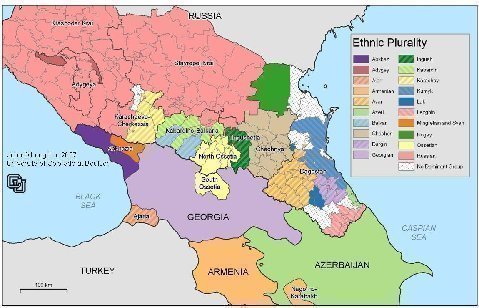
In December 1914, about the time when the BEF was hunkering down in Ypres on the Western Front, the Ottoman Ninh Corps were sent to surround the Russians in Sarikamis. The strategy, at first, seemed to be working, except when crossing through the mountains in East Anatolia, winter fell, which affected the Ottoman soldiers greatly. Enver Pasha, the Ottoman commander, encouraged the Ottomans forward by telling the soldiers that he could see that they did not have shoes or coats, but, "the enemy is afraid of you." However, with the cold weather and snow many Ottoman soldiers died of the cold.
While the Ottomans were retreating, they were supposedly fired at by Russians and rebel Armenians. Enver Pasha blamed the Caucasus Campaign defeat on these rebel Armenians serving with the Russians, though historians say the Armenian role was more imagined than real. However, here, in the Ottoman defeat at the hands of the Russians, the seeds of the Armenian genocide are sewn.
The Germans had been supportive of the Caucasus campaign thinking that Ottoman gains there would take pressure off of them on the Eastern Front... by drawing more Russian soldiers to the Caucus region. It was not to be... at least to any great significance.
Ottoman casualties in the Caucasus campaign were high. 9000 killed. 3000 prisoners, 2800 deserters.
Fighting continued on the Caucasus front, including later, to the South between the Ottomans and Commonwealth forces, until the end of the war. However, no gains were made by the Ottomans on the Caucasus front after their defeat by the Russians in December 1914. One place where Ottoman troops distinguished themselves, however, was, of course, Gallipoli... between April 2015 and December 2015.
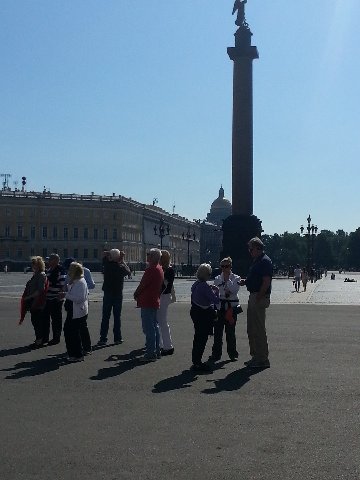
Above: Wayward tourists stand, confused, looking for their vehicle, in Dvortsovaya Ploshchad (Palace Square), St. Petersburg, Russia. Far right, TIMDT, Bronx Girl, Basketball. 8 June 2013.
Image is against the sun, but the angle was the only way to also capture the important monuments in the background: Alexander Column, and further on, St. Isaac's Cathedral.
Like WWII, Americans tend to see WWI from a Western Front point of view (those that are aware at all). The Eastern Front gets short shrift. Yet, no one country suffered more military deaths (all causes) in WWI than Russia: 2.3 million (Total Entente military deaths, 6.4MM).
The military disasters at the Masurian Lakes and Tannenberg early in 1914, early in the war, greatly weakened the Russian Army. The growing influence of Gregory Rasputin over the Romanov's did a great deal to damage the royal family and by the end of the spring of 1917, the Romanovs, who had ruled Russia for just over 300 years, were no longer in charge of a Russia that had been taken over by Kerensky and the Provisional Government. By the end of 1917, the Bolsheviks, led by Lenin, had taken power of the major cities of Russia and introduced communist rule in those areas it controlled.
Ironically, as the Russian monarchy was disintegrating, the Russian Brusilov Offensive, which began on 04 June 1916, was the largest and most successful Allied offensive of World War I. We hear of Somme and Verdun... but Brusilov?
Entente powers met at Chantilly in December of 1915. There, offensives against the Central Powers were planned: Somme on the Western Front and Galatia on the Eastern Front. Then, in early 1916, the German attack on Verdun "intervened." The French had to divert troops intended for Somme to Verdun. It became even more important for the Russians to mount an offensive on the Eastern Front to divert German troops away from the Western Front.
Russian General Brusilov's troops began attacks on the Austro-Hungarian Army at Lutsk (now in Ukraine), on 04 June 1916 with a bombardment from nearly 2000 guns along a 200 mile long front. The success of the barrage canceled out a troop numbers advantage. Brusilov's troops took 26,000 Austrian prisoners the first day.
Within two days, the Russians had broken the Austrians, advancing 60 miles along a 16 mile long front. some 130,000 casualties - plus the capture of over 200,000 prisoners - forced the Austrian commander, Conrad von Hotzendorff, to close down an offensive against Italy to divert guns and divisions back east. Conrad told his German counterpart, von Falkenhayn, that the Austrians were facing the greatest crisis of the war so far. This revelation took Falkenhayn, who was then optimistic about an imminent French surrender at Verdun, completely by surprise. Confronted with the Austrian panic against Russia, Falkenhayn was forced to release four German divisions from the west, a weakness that allowed a successful French counterattack at Verdun on 23 June 1916... just one day before the preliminary British artillery bombardment began at the Somme.
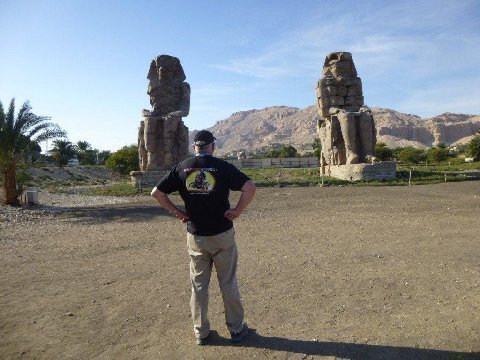
Above: The Bishop observes the Collossi of Memnon. Luxor, Egypt. 16 November 2012.
After studying my freshman year of college at American University in Cairo in 1963/64, I subsequently visited Egypt three times, the latest being November 2012.
The British 29th Division and the ANZAC divisions moved to Egypt in late 1914 as a base of operations at Gallipoli which began in April 1915.
Today the land where the British forces were active in 1914-1918 lies in Egypt, Israel, Jordan, Saudi Arabia and Syria. For centuries before the Great War, this land had been part of the Ottoman Empire. "Palestine" is a shorthand for this theatre of WWI applied to a widespread conflict that was initially centered along the banks of the Suez Canal, which links the Red Sea and the Mediterranean Sea, in Egypt. Later, operations were necessary in the Hejaz, in Aden, and Saudi Arabia. In 1917 an offensive was launched which took British troops into the Holy Land and Syria. The Arab tribes in the area played an important part in the war, some rising against the British, and many against the Ottomans.
From 1917, Field Marshal Viscount Allenby was the leader of Allied efforts in Egypt/Palestine, where he led the British Empire's Egyptian Expeditionary Force (EEF). Before coming to Egypt, Allenby had led cavalry and BEF Divisional forces on the Western Front.
In the Sinai and Palestine Campaign, Allenby captured Beersheba, Jaffa and Jerusalem (October to December 1917). After occupying the Jordan Valley during the summer of 1918, he went on to capture northern Palestine and defeat Yildirim Army Group's Eighth Army at the Battle of Megiddo. The EEF pursuit by Desert Mounted Corps captured Damascus and advanced into northern Syria. During this pursuit Allenby commanded T. E. Lawrence, whose campaign with Faisal's Arab Sherifial Forces assisted the EEF's capture of Ottoman Empire territory. Allenby fought the battle of Aleppo, five days before the Armistice of Mudoros on 20 October 1918, ended his campaign. Allenby continued to serve in the region as High Commissioner for Egypt and the Sudan from 1919 to 1925. Reminds of Mc Arthur with his "staying on."

Above: Gulf of Aqaba... Eliat, Israel in the distance. Image captured by the Bishop from Seabourn cruise ship. 12 November 2012.
Aqaba was famously captured by T.E. Lawrence and Faisal's Arab Sherifial Forces.
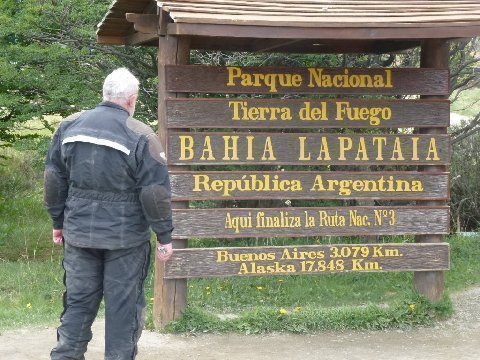
Above: The Bishop, in motorcycle riding duds, at Tierra del Fuego, Argentina. 17 November 2011.
Argentina was neutral in WWI. However, 1917, German sunk three Argentinian ships heading towards Great Britain. Several Argentine groups pushed for a declaration of war against Germany. A German telegram was intercepted, and it turned out that the German ambassador Karl Von Luxburg had referred to the Argentine Chancellor as a "donkey," and had recommended sinking Argentine ships without leaving any trace.
The German ambassador was sacked and Argentina remained neutral. Argentina exported wheat to Germany during the war. It is surprising that Germany would want to antagonize Argentina and risk giving up on the wheat exports.
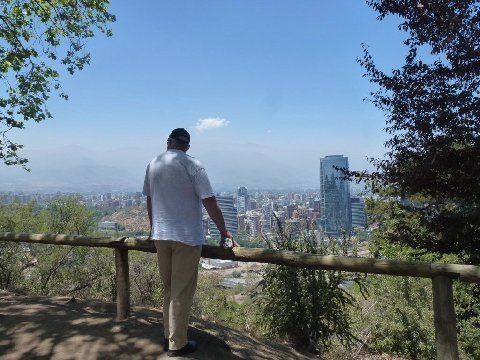
Above: The Bishop surveys Santiago, Chile. 05 December 2011.
The WWI Battle of Coronel took place on 01 November 2014 off the coast of central Chile, near the city of Coronel. German forces led by Vice-Admiral Graf Maximilian von Spee met and defeated a Royal Navy squadron commanded by Rear-Admiral Sir Chrstopher Cradock.
The engagement probably took place as a result of a series of misunderstandings. Neither admiral expected to meet the other in full force. Once the two met, Cradock understood his orders were to fight to the end, despite the odds heavily against him. Although Spee had an easy victory, destroying two enemy armored cruisers for just three men injured, the engagement also cost him almost half his supply of ammunition, which was impossible to replace. Shock at the British losses led to an immediate reaction and the sending of more ships which in turn destroyed Spee and the majority of his squadron at the Battle of the Falkland Islands.
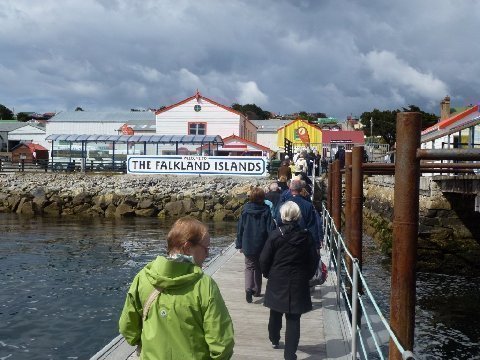
Above: TIMDT (black coat) disembarking at Stanley, Falkland Islands, 25 November 2011.
The Battle of the Falkland Islands was a British naval victory over the German Navy on 08 December 1914 during WWI in the South Atlantic.
The British, after a defeat at the Battle of Coronel on 01 November 1918, sent a large force to track down and destroy the victorious German cruiser squadron.
Admiral von Spee, command a German squadron of two armored cruisers, two light cruisers, and three auxiliaries, attempted to raid the British supply base at Stanley in the Falkland Islands. A larger British squadron, consisting of two battle cruisers, three armored cruisers, an armed merchant cruiser, and two light cruisers had arrived in the port only the day before.
Visibility was at its maximum, the sea was placid with a gentle breeze from the northwest, and the day was bright and sunny. The advance cruisers of the German squadron had been detected early on. By nine o'clock that morning the British battlecruisers and cruisers were in hot pursuit of the five German vessels, these having taken flight in the line abreast to the southeast. All but two German ships were unted down and sunk.

Above: MDT at changing of the guards at Amalienborg Palace, home of Danish Royalty ( Queen Margreth II). Copenhagen, Denmark, 25 May 2011.
One of the factors that led to WWI was the German naval buildup. Britain, who ruled the seas, had cause to be nervous. Tensions between the two nations, naturally heightened as the Kaiser built his Navy.
Admittedly, during our two recent visits (another in 2013) to Copenhagen, WWI did not enter into our thinking. Yet, just off the west coast of the Jutland Peninsula (Denmark) occurred WWI's greatest sea battle. The Battle of Jutland.
There were two major phases of the battle. Late afternoon, 31 May 1916 (only a month before the beginning of the battle of the Somme, a couple of months after the German offensive at Verdun, and just 5 days before the start of the Brusilov offensive on the Eastern Front), German and British scouting forces commenced a running artillery duel at fifteen thousand yards... just off Denmark's North Sea coast. British commander Beatty lost three battle cruisers due to lack of antiflash protection in the gun turrets, which allowed fires started by incoming shells to reach the powder magazines. Commenting that "there seems to be something wrong with our bloody ships today," Beatty after this initial encounter turned north and lured the Germans in to the British Grand Fleet.
The second phase of the battle started at 7:15 PM when British admiral John Jellicoe brought his ships into a single battle line by executing a 90-degree wheel to port. Gaining the advantage of the fading light, he cut the Germans off from their home base and twice crossed the German High Fleet's "T." German ships took seventy direct hits, while scoring but twenty against Jellicoe: The German fleet escaped certain annihilation only by executing three brilliant 180 degree battle turns away. By the full darkness at 10:00 PM, British losses amounted to 6,784 men and 111,000 tons, and German losses to 3,058 men and 62,000 tons.
Germans declared victory, but by the end of the battle Jellicoe still had twenty-four untouched dreadnoughts and battle cruisers blocking German exit to the North Sea, while Scheer kept his ten battle-ready heavy units in port. Three German battle cruisers and three dreadnoughts required extensive repairs.
Strategically, Jutland is compared to the Battle of Trafalgar. The German High Fleet had been driven home and would put out to sea only three more times on minor sweeps. Like the French after Trafalgar, the Germans turned to commerce raiding... trying, rather to seek the defeat of British economic life by using U-boats against British trade.
The British public was disappointed with Jutland. However, Churchill noted that "Jellicoe was the one man who could have lost the war in an afternoon. Jutland, instead, proved Jellicoe's mettle.

Above: Schematic. Battle of Jutland.31 May 2016.
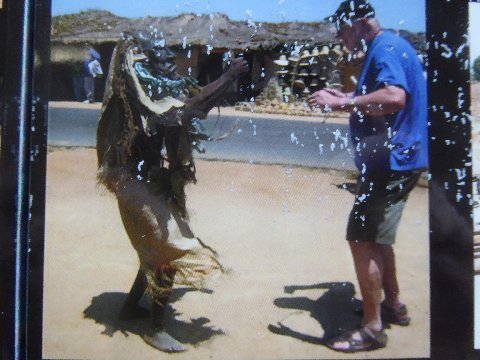
Above: The Bishop dances with medicine man. Lilongwe, Malawi. 2008.
During 2008 The Bishop rode a BMW K1200 LT motorcycle from Johannesburg, South Africa, through Botswana, Namibia, Zambia, Zimbabwe, Malawi, and Tanzania... to Dar es Salaam... areas of conflict during WWI. 3000 motorcycle miles covered in three weeks.
There were two areas of conflict in Africa at the declaration of war in 1914.
The first was in southern Africa between German South West Africa (now Namibia) and the British Union of South Africa. This campaign was relatively clean and quick and exacted little loss of life on either side... and, was concluded in favor of the Allies. The Germans offered occasional resistance, but otherwise were overwhelmed. They tended to take the view that there was little to be gained in diverting resources to the colonies when an Axis victory in Europe was inevitable.
What the southwest African campaign of WWI did achieve was to elevate the South African Second-in-Command, Jan Christian Smuts, to the A-list of Imperial military commanders.
The second campaign was the East Africa Campaign. Each of German Tanganyika (today Tanzania) and British Kenya had colonial leaders who would have rather avoided fighting one another. However, at the war's outset, local military commanders - and settlers - of each territory demanded action.
The Germans had an in situ competent military commander. Colonel Paul von Lettow Vorbeck. The British rushed to arms in somewhat of an ad hoc way, under a variety of settle militias. Both sides were under strength and poorly trained.
The first offensive came from the British who attempted an amphibious landing at Tanga. The British force was mainly drawn from India and the German force was mainly native. Under the able command of Vorbeck, the Germans prevailed. The British defeat increased, somewhat, confidence among Germans that a colonial resistance might work.
The Germans went on the offensive, primarily using guerilla tactics, to disrupt the Uganda Railway and other British installations in the Kilimanjaro area, close to Kenya and the British port of Mombassa. Vorbeck felt that, considering the power of the British Navy and the more extensive British colonial presence around the world, that the Germans would eventually lose in Africa. He, therefore, saw his role as disrupting British supply lines via guerilla actions.
In 1916, after having taken German South West Africa, General Smuts brought troops north to Tanganika. Although the British occupied German East Africa fairly soon after Smuts' arrival in the theater, the East Africa Campaign itself was not concluded until a few weeks after the armistice was signed. Vorbeck emerged from the African struggle as a national hero in a nation bitterly defeated and hungry for heroes. Smuts moved on into higher and greater levels of statesmanship and diplomacy, while in the scattered graveyards of East Africa, and indeed in the convalescent homes from Cape Town to Bombay, palsied, fevered and shell shocked men died of residual illness or struggled towards recovery.
In the aftermath of the war, the two territories of German South West and East Africa became South African and British mandated territories.
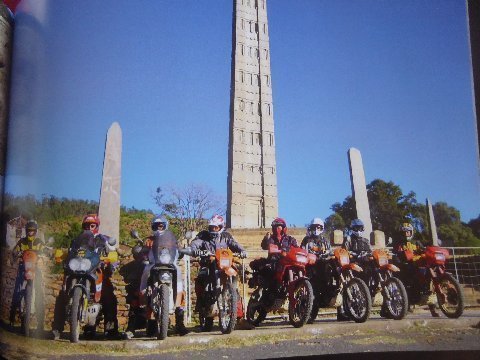
Above: The Bishop on Honda Africa Twin motorcycle, 2nd from left, Axum, Ethiopia. 2006.
Ethiopia was not a belligerent in WWI. However WWI touched Ethiopia as it impacted on local politics. WWI was a major reason for the downfall in 1916 of Lij Iyasu, the Crown Prince of Ethiopia, was was pursuing a pro-German, pro-Ottoman policy. This policy was opposed by Dejazmach Teferi Mekonen (later Emeror Haile Selassie) and the emrging class of educated Ethiopians.
The Commonwealth War Graves cemetery in Hargeisa, Somaliland records the names of 115 casualties from the Indian Army and Somaliland Camel Corps. Ethiopian troops also saw action during WWI alongside British and Italian allies on the WWI Italian Front.
Addendum:
another very educational ,well crafted piece thanks Steve.
Brand,
Venice, CA
Steve,
Thank you so much for these fascinating posts on your 8 day tour of WWI sites. Your series of posts on WWI have been a real eye opener for me. While I have studied a bit about WWI, the enormity of the death and injuries sustained by people on both sides has impacted me as never before. It truly is beyond comprehension.
The willingness of these countries to fight and then fight again after so many casualties just a few years later baffles me.
I had a great uncle who fought and was injured in WWI. He was disabled the rest of his life. I never heard him say a word about the war, even though I spent many hours with him in my youth. I wish he were still alive so I could learn more about his experience. That generation is all gone now. The generation that fought WWII is mostly gone. I feel like we have lost so much wisdom and experience with their passing.
Regards,
Delhi PJs, West Jordan, UT
Steve:
Nice blogging! Really enjoyed this.
As a Vietnam vet I will reply. Yes. It does. It gives a life time of perspective. What's important takes on a whole different context that never eludes you.
BTW we rode together a few years ago in S. America on a ride with Phil Freeman through Patagonia to Terra del Fuego.
Thanks for the vacation ideas; Turkey, Yugoslavia and the WWI trips have all been an eye opener.
Bill Vanover